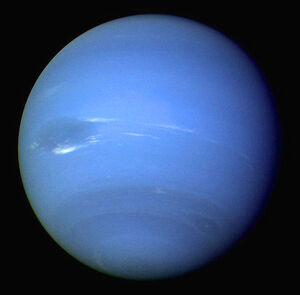Neptune is the eighth planet from the sun at a distance of about 4.5 billion km (2.8 billion miles) or 30.07 AU. It is named after the Roman god of the sea.[1] and here is photo here
Orbit[]
One day on Neptune takes about 16 hours (the time it takes for Neptune to rotate or spin once). Neptune makes a complete orbit around the sun (a year in Neptunian time) in about 165 Earth years (60,190 Earth days).[1]
Neptune will reach opposition to Earth on September 11/12, 2020.[2]
Atmosphere[]
Neptune's atmosphere is made up mostly of hydrogen (H2), helium (He) and methane (CH4).[1]
Composition[]
Neptune is a sister ice giant to Uranus. Neptune is mostly made of a very thick, very hot combination of water (H2O), ammonia (NH3), and methane (CH4) over a possible heavier, approximately Earth-sized, solid core.[1]
Moons[]
Neptune has 14 moons. Neptune's moons are named after various sea gods/goddesses and nymphs in Greek mythology.[1][future] triton will collide to neptune or ripped and teared apart into pieces forming its new rings
Rings[]
Neptune has six invisible rings.
Missions[]
Voyager 2 is the only spacecraft to have visited Neptune.[1]
Facts[]
- Neptune crosses orbits with Pluto once in awhile.
- Sometimes, during the course of Neptune's orbit, dwarf planet Pluto is actually closer to the sun, and us, than Neptune. This is due to the unusual elliptical (egg) shape orbit of Pluto.[1]
- The element Neptunium is named after this planet.
|
|
